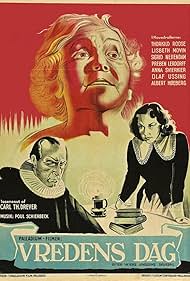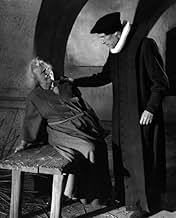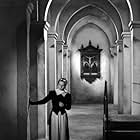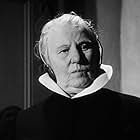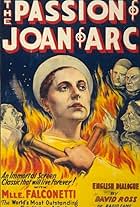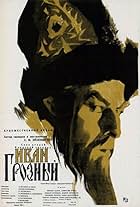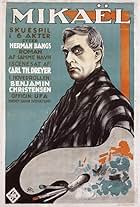The young wife of an aging priest falls in love with his son amidst the horror of a merciless witch hunt in 17th-century Denmark.The young wife of an aging priest falls in love with his son amidst the horror of a merciless witch hunt in 17th-century Denmark.The young wife of an aging priest falls in love with his son amidst the horror of a merciless witch hunt in 17th-century Denmark.
- Awards
- 1 win & 1 nomination
Thorkild Roose
- Rev. Absalon Pederssøn
- (uncredited)
Sigrid Neiiendam
- Merete (Absalon's mother)
- (uncredited)
Albert Høeberg
- The Bishop
- (uncredited)
Preben Neergaard
- Degn
- (uncredited)
Anna Svierkier
- Herlofs Marte
- (uncredited)
Olaf Ussing
- Laurentius
- (uncredited)
Storyline
Did you know
- TriviaThere was a gap of eleven years between this film and Dreyer's last feature, being Vampyr in 1932.
- GoofsThe film is set in 1623. But at the back of the main room, where much of the action takes place, is a large wooden chest with a Latin inscription: "Quodque parum novit nemo docere potest - Anno 1639."
- Quotes
Anne Pedersdotter: I see through my tears, but no one comes to wipe them away.
Featured review
Sure, now it might be difficult to appreciate this for how far it went. We've had Bergman since, Tarkovsky, Haneke most lately, they all begin here. At the time Ozu was still on his way. Bresson had yet to begin. And there's the notion of a Nazi allegory, more likely applied in retrospect, that runs the risk of reducing the work to one convenient reading that simplifies.
So Dreyer was one of the first to arrive, but where to? A world distilled to purity, long quiet utterances of the camera, waxen faces sunken by inward weight, sensuous nature outside contrasted with pious suffering inside the pastor's house.
Contemporary viewers might find all this a bit too musky and too archaic, something fabled from a medieval world, and watch with detached, at best aesthetic interest. But that would be to turn a blind eye to the real engines that power ignorance and delusion all around us, these haven't changed a bit since Dreyer's time or the 1600s.
The film begins and ends with horrible punishment at the hands of a cruel establishment; but it's the unswathing of the soul in that interim space where people are alone with the questions they have about each other that matters. Let the story of religious persecution subside and this is about ordinary people who struggle with what they feel moves them.
A man betrayed his austere god, from his own end, when he allowed a 'witch' to go unpunished so he could take her beautiful daughter for a wife. The film begins with the wrongdoing appearing again around him. Another woman rumored to be a witch is apprehended and begs for the same forgiveness. That's on the same day as his son is coming to visit and meets a stepmother his own age.
From her own end, she has been locked in a suffocating household and loveless marriage, the young man before her is everything a woman her age would pine for. We have that life take shape as a hushed love affair, it begins with a lacy image of a woman and a boy holding hands that she stitches, then a promenade out in nature that envelops and sways with the promise.
Bergman would lengthen the monologues into articulate introspection, overbearingly so, Tarkovsky would take these same long pans of the camera, set the cut further back and seep with them in and out of dreams and consciousness. Dreyer sweats out the angst with the same stoic forbearance throughout; words are measured, flows are austere. Self is not penetrated here then, by way of words or camera, we infer opaquely from the outside. It will depend on the viewer if he finds all this hypnotic or oppressive; me, I favor cessation when it leads to realization.
So the household is devastated by the discovery, someone has fallen to die, love is now tainted and sinking. That's the dramatic turn of events, presbyterian. Questions I find immensely more interesting, quite apart from anything about religious persecution, is what is taking place inside these people?
He reserves bitter irony for the end, now she resigns to being the character in a wretched story shaped by idiots, but points also to this fickleness to make ourselves known, to our own selves first; it seems like he was ready to love to the end, a potentially happy life ahead of them, but at the last moment he steps on the accusing side of the room. Truth sunk by belief in a story about evil powers. Does he truly believe it, does he conveniently extricate himself? It's the same delusion either way.
So Dreyer was one of the first to arrive, but where to? A world distilled to purity, long quiet utterances of the camera, waxen faces sunken by inward weight, sensuous nature outside contrasted with pious suffering inside the pastor's house.
Contemporary viewers might find all this a bit too musky and too archaic, something fabled from a medieval world, and watch with detached, at best aesthetic interest. But that would be to turn a blind eye to the real engines that power ignorance and delusion all around us, these haven't changed a bit since Dreyer's time or the 1600s.
The film begins and ends with horrible punishment at the hands of a cruel establishment; but it's the unswathing of the soul in that interim space where people are alone with the questions they have about each other that matters. Let the story of religious persecution subside and this is about ordinary people who struggle with what they feel moves them.
A man betrayed his austere god, from his own end, when he allowed a 'witch' to go unpunished so he could take her beautiful daughter for a wife. The film begins with the wrongdoing appearing again around him. Another woman rumored to be a witch is apprehended and begs for the same forgiveness. That's on the same day as his son is coming to visit and meets a stepmother his own age.
From her own end, she has been locked in a suffocating household and loveless marriage, the young man before her is everything a woman her age would pine for. We have that life take shape as a hushed love affair, it begins with a lacy image of a woman and a boy holding hands that she stitches, then a promenade out in nature that envelops and sways with the promise.
Bergman would lengthen the monologues into articulate introspection, overbearingly so, Tarkovsky would take these same long pans of the camera, set the cut further back and seep with them in and out of dreams and consciousness. Dreyer sweats out the angst with the same stoic forbearance throughout; words are measured, flows are austere. Self is not penetrated here then, by way of words or camera, we infer opaquely from the outside. It will depend on the viewer if he finds all this hypnotic or oppressive; me, I favor cessation when it leads to realization.
So the household is devastated by the discovery, someone has fallen to die, love is now tainted and sinking. That's the dramatic turn of events, presbyterian. Questions I find immensely more interesting, quite apart from anything about religious persecution, is what is taking place inside these people?
He reserves bitter irony for the end, now she resigns to being the character in a wretched story shaped by idiots, but points also to this fickleness to make ourselves known, to our own selves first; it seems like he was ready to love to the end, a potentially happy life ahead of them, but at the last moment he steps on the accusing side of the room. Truth sunk by belief in a story about evil powers. Does he truly believe it, does he conveniently extricate himself? It's the same delusion either way.
- chaos-rampant
- Feb 23, 2016
- Permalink
- How long is Day of Wrath?Powered by Alexa
Details
- Release date
- Country of origin
- Language
- Also known as
- El día de la ira
- Production company
- See more company credits at IMDbPro
Box office
- Gross US & Canada
- $7,642
- Runtime1 hour 50 minutes
- Color
- Sound mix
- Aspect ratio
- 1.37 : 1
Contribute to this page
Suggest an edit or add missing content

